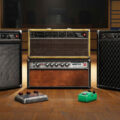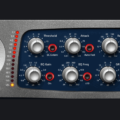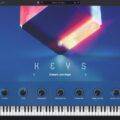Guitar Rig is likely one of the most famous amp simulator plugins in the market. Despite various brands like IK Multimedia, Positive Grid, Brainworx, Neural DSP releasing their own amp simulators, Guitar Rig, launched in 2004, has maintained high visibility in the guitar software market, updating to version 7 this year.

The Guitar Rig 7, released three years after version 6 in 2020, brings some notable updates. The Intelligent Circuit Modeling (ICM) technology, introduced in Guitar Rig 6, is expanded to include more amps. According to Native Instruments, ICM uses machine learning to precisely replicate the feel of hardware.
Additionally, features added through a collaboration with iZotope catch attention. The 'Kolor' saturation plugin, adding color to the tone, includes two settings from iZotope's Trash. Moreover, the Maximizer module from Ozone is incorporated, providing effective control over guitar track volumes.

Guitar Rig has traditionally stuck to a rack-style interface design. However, version 7 introduces a sidebar on the right, allowing users to see the signal flow of connected modules at a glance. Users can drag and rearrange modules easily by looking at the sidebar.

Amp Modeling Quality in Guitar Rig 7 Pro
As of 2023, most amp simulators already deliver high-quality sound. However, Guitar Rig's amp modeling leans towards convenience rather than hyper-realism. This doesn't mean Guitar Rig sounds bad; it provides well-crafted and clean tones.
Compared to products like Amplitube or Brainworx, Guitar Rig offers a smoother feel with less gritty texture. The noise gate effectively manages noise without compromising the overall tone.

If you're seeking ultra-realistic amp sounds or the raw feel of a tube amp, Guitar Rig's sound might not align with your preferences. However, for composers and producers needing clean and organized guitar recordings, it's incredibly convenient.
Regarding mic positioning, unlike Amplitube's extensive options, Guitar Rig offers two mic settings with the ability to blend distances. While this may be a limitation for users wanting intricate control, it's a user-friendly feature for those who prefer adjusting mic distance and room tone with a single slider.
Diverse Presets Offered
One standout feature that sets Guitar Rig apart is its multitude of presets. Unlike some products that focus on amp head settings and basic effects, Guitar Rig shines when it comes to incorporating various FX modules in a rack-style setup.
Starting from simple guitar effect pedals like overdrive, distortion, delay, and reverb, Guitar Rig allows users to explore harmonic exciters, synthesizers, and unique spatial effects. Even without delving into individual module settings, the default presets provide a wide range of tones.
This is a significant advantage for composers and producers, offering the opportunity to experiment with a plethora of effects almost at the level of synthesizers. Guitar Rig is not limited to guitars; it can be used as an effective effects processor for drums, EP, and other instruments, thanks to presets tailored to different input styles.
Input/Output Gain Staging
Amp simulators respond richly to input gain control, and Guitar Rig is no exception. While it tends to deliver clean tones, pushing the input gain provides enough room for gritty tone shaping. However, for experiencing the effects of various modules and presets, excessively raising the input gain is unnecessary. Desired effects can be achieved with minimal gain.
Output gain staging is also convenient. Avoiding clipping issues is easily managed with built-in limiters, Ozone's maximizer, and volume modules. Balancing the volume gap between clean and driven tones is effortlessly achievable.

Conclusion on Guitar Rig 7 Pro
I had preconceived notions about Guitar Rig, perhaps originating from older versions, considering its sound as 'bland' for a player. Rediscovering the sound of Guitar Rig was a revelation, showcasing how much the quality gap in amp simulator plugins has diminished.
As performance levels equalize, having a clear target audience or design philosophy is crucial for differentiation. Guitar Rig stands out with its creative and diverse sound experiences based on presets, offering a unique distinction from other plugins.
The emphasis on preset-driven, creative, and varied sound experiences sets Guitar Rig apart. The plugin provides a unique differentiator in a market where performance levels are increasingly standardized.
This article was published in partnership with Monthly Mixing.




